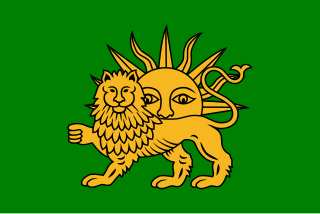 W
WArdabil Khanate was an 18th-19th century khanate based in Ardabil. The khanate is known as one of the khanates, located in historic Azerbaijan, which remained semi-independent for 61 years.
 W
WThe family of Baban (1649–1850) ruled a Kurdish principality which encompassed areas of present-day Iraqi Kurdistan and western Iran from the early 17th century until 1850. The Baban principality played an active role in Ottoman-Persian conflict. The founder of the princely Baban family is thought to be Ahmad Faqih or Faqi Ahmad from the district of Pijder. The Babans claimed descent from a Frankish woman, Keghan, who was taken prisoner in a battle by the Ottomans. According to the Sharafnama the clan's first chief was Pir Badak Babe, who is believed to have lived around 1500.
 W
WThe Battle of Krtsanisi was fought between the Qajar Iran (Persia) and the Georgian armies of the Kingdom of Kartli-Kakheti and Kingdom of Imereti at the place of Krtsanisi near Tbilisi, Georgia, from September 8 to September 11, 1795, as part of Agha Mohammad Khan Qajar's war in response to King Heraclius II of Georgia’s alliance with the Russian Empire. The battle resulted in the decisive defeat of the Georgians, capture, and complete destruction of their capital Tbilisi, as well as the temporary absorption of eastern parts of Georgia into the Iranian Empire.
 W
WBeylerbey or Beylerbeyi was a high rank in the western Islamic world in the late Middle Ages and early modern period, from the Seljuks of Rum and the Ilkhanids to Safavid Persia and the Ottoman Empire. Initially designating a commander-in-chief, it eventually came to be held by senior provincial governors. In Ottoman usage, where the rank survived the longest, it designated the governors-general of some of the largest and most important provinces, although in later centuries it became devalued into a mere honorific title. Its equivalents in Arabic were amir al-umara, and in Persian, mir-i miran.
 W
WThe campaigns of Nader Shah, or the Naderian Wars, were a series of conflicts fought in the early to mid-eighteenth century throughout Central Eurasia primarily by the Iranian conqueror Nader Shah. His campaigns originated from the overthrow of the Iranian Safavid dynasty by the Hotaki Afghans. In the ensuing collapse and fragmentation of the empire after the capture of the Iranian capital of Isfahan by the Afghans, a claimant to the Safavid throne, Tahmasp II, accepted Nader into his service. After having subdued north-west Iran as well as neutralising the Abdali Afghans to the east as well as turning Tahmasp II into a vassal, Nader marched against the Hotaki Afghans in occupation of the rest of the country. In a series of incredible victories the Afghans were decimated and Tahmasp II returned to the throne as a restored Safavid monarch.
 W
WThe Hotak dynasty was an Afghan monarchy of the Ghilji Pashtuns. It was established in April 1709 by Mirwais Hotak who lead a successful revolution against their declining Persian Safavid overlords in the region of Loy Kandahar in what is now southern Afghanistan. It lasted until 1738 when the founder of the Afsharid dynasty, Nader Shah Afshar, defeated Hussain Hotak during the long siege of Kandahar. Subsequently, Nader Shah Afshar, began reestablishing Iranian suzerainty over regions lost decades before to the Iranian archrival, the Ottoman Empire, and the Russian Empire. At its peak, the Hotak dynasty ruled briefly over an area which is now Afghanistan, Iran, western Pakistan, and some parts of Tajikistan and Turkmenistan.
 W
WKaradagh Khanate, was a khanate established in the 18th century, with its capital being Ahar.
 W
WThe khanates of the Caucasus, or Azerbaijani khanates or Persian khanates, or Iranian khanates, were various provinces and principalities established by Persia (Iran) on their territories in the Caucasus from the late Safavid to the Qajar dynasty. The Khanates were mostly ruled by Khans of Turkic (Azeri) origin and were vassals and subjects of the Iranian shah (King). Persia permanently lost a part of these khanates to Russia as a result of the Russo-Persian Wars in the course of the 19th century, while the others were absorbed into Persia.
 W
WThe Kingdom of Ormus was located in the eastern side the Persian Gulf and extending as far as Bahrain in the west in its zenith. The Kingdom was established by an Omani prince in the 11th century initially as a dependency of the Kerman Seljuk Sultanate, and later as an autonomous tributary of the Salghurids and the Ilkhanate of Iran. Ormus later became a client state of the Portuguese Empire, most of its territory was eventually annexed by the Safavid Empire in the 17th century.
 W
WThe Peace of Amasya was a treaty agreed to on May 29, 1555 between Shah Tahmasp of Safavid Iran and Sultan Suleiman the Magnificent of the Ottoman Empire at the city of Amasya, following the Ottoman–Safavid War of 1532–1555.
 W
WThe Persian Empire or Imperial Iran is any one of the many imperial dynasties centred in Iran (Persia) from the 6th century BC, the Achaemenid Empire, to the 20th century, the Pahlavi dynasty.
 W
WThe Safavid dynasty was one of the most significant ruling dynasties of Iran from 1501 to 1736. The Safavid dynasty had its origin in the Safavid order of Sufism, which was established in the city of Ardabil in the Iranian Azerbaijan region. It was an Iranian dynasty of Kurdish origin, but during their rule they intermarried with Turkoman, Georgian, Circassian, and Pontic Greek dignitaries. From their base in Ardabil, the Safavids established control over parts of Greater Iran and reasserted the Iranian identity of the region, thus becoming the first native dynasty since the Sasanian Empire to establish a national state officially known as Iran.
 W
WSafavid Iran or Safavid Persia, also referred to as the Safavid Empire, was one of the greatest Iranian empires after the 7th-century Muslim conquest of Persia, ruled from 1501 to 1736 by the Safavid dynasty. It is often considered the beginning of modern Iranian history, as well as one of the gunpowder empires. The Safavid shahs established the Twelver school of Shia Islam as the official religion of the empire, marking one of the most important turning points in Muslim history.
 W
WTabaristan, also known as Tapuria, was the name applied to Mazandaran, a province in northern Iran. Although the natives of the region knew it as Mazandaran, the region was called Tabaristan since the Sassanid era.
 W
WThe Tabriz khanate was one of the Caucasian Khanates, located in historic Azerbaijan which remained semi-independent for 55 years.
 W
WThe composite Turco-Persian tradition refers to a distinctive culture that arose in the 9th and 10th centuries in Khorasan and Transoxiana. It was Persianate in that it was centered on a lettered tradition of Iranian origin and it was Turkic insofar as it was founded by and for many generations patronized by rulers of Turkic heredity. In subsequent centuries, the Turco-Persian culture would be carried on further by the conquering peoples to neighbouring regions, eventually becoming the predominant culture of the ruling and elite classes of South Asia, Central Asia and Tarim basin and large parts of West Asia.
 W
WUrmia Khanate was one of the Caucasian khanates. Existing from 1747-1865, it was founded by Fath-Ali Khan Afshar and it was located in historic Azerbaijan.
 W
WThe Zand dynasty was an Iranian dynasty, a branch of Lurs or Kurds, origin founded by Karim Khan Zand that initially ruled southern and central Iran in the 18th century. It later quickly came to expand to include much of the rest of contemporary Iran, as well as Azerbaijan, Bahrain, and parts of Iraq and Armenia.